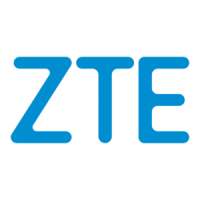
Do you have a question about the Zte ZXR10 2928 and is the answer not in the manual?
| MAC Address Table Size | 16K |
|---|---|
| VLAN | 4K |
| Jumbo Frame | 9K |
| Power Supply | AC 100-240V, 50/60Hz |
| Power Consumption | < 30W |
| Dimensions | 440mm x 200mm x 44mm |
| Operating Temperature | 0°C to 45°C |
| Storage Temperature | -40°C to 70°C |
| Operating Humidity | 10% to 90% non-condensing |
| Storage Humidity | 5% to 95% non-condensing |
| Ports | 24 x 10/100/1000Base-T ports, 4 x GE SFP ports |
Introduces safety instructions and sign descriptions for the device.
Details safety precautions for installation, operation, and maintenance.
Introduces the product overview, its functions, and technical features.
Describes the ZXR10 2920/2928/2952 series as megabit L2+ Ethernet switches.
Details the layer-2 switching at wire-speed and port capabilities.
Highlights link redundancy, STP/RSTP/MSTP, LACP, and Ethernet ring mode.
Lists operation characteristics like VLAN sort, QinQ, VBAS, and multicast technology.
Details user, equipment, and network security measures.
Explains QoS applications like 802.1p, DSCP, and CAR functions.
Covers SNMP, RMON, CLI, and Web management for the switch.
Lists key functions like Store and Forward, self-adapting ports, flow control, VLAN, LACP, and STP.
Introduces working principle, technical, and hardware structural information.
Explains the core components: Control, Switching, and Interface modules.
Describes the box structure, 1U height, natural dissipation, and light weight.
Provides an overview of installation and debugging processes.
Details placement options for desktop and 19-inch cabinet installation.
Describes installing plastic pads for desktop placement and ventilation.
Explains attaching flanges for 19-inch cabinet installation.
Lists the types of cables used: power, console, network, and fiber optics.
Details AC and DC power cable classifications and installation.
Explains console cable connections and linear ordering.
Covers RJ45 connector types and specifications for network cables.
Describes optical interface connection and fiber types.
Explains the pattern and meanings of labels on panels and connectors.
Details lightning protection measures for cables and ports.
Covers configuration modes, command mode, and command line use.
Explains various modes like Serial Port, Telnet, SNMP, and Web connection.
Details the primary configuration method using a console port.
Guides on configuring the switch via Telnet.
Overview and features of SNMP for network management.
Steps for configuring web-based management.
Explains different command modes like User, Global, SNMP, etc.
Introduces file system management, FTP/TFTP, backup, and software upgrade.
Details file system operations on Flash memory.
Explains file operations using commands like config tffs, md, remove.
Guides on setting up the switch as a TFTP client.
Covers exporting and importing configuration information.
Explains procedures for backing up and restoring files.
Details steps for upgrading the switch software version.
Shows how to view hardware and software versions using 'show version'.
Provides steps for software upgrade in normal system conditions.
Details software upgrade procedure when the system fails to start.
Introduces configuration methods for various services.
Covers basic port parameters, display, and mirroring.
Explains VLAN concepts and configuration.
Defines MAC address and forwarding database (FDB).
Covers MAC filter, static address binding, and aging time.
Explains Link Aggregation Control Protocol (LACP) and its standards.
Guides on enabling/disabling LACP and configuring aggregator/port modes.
Explains IGMP snooping and its benefits for multicast traffic.
Details enabling/disabling IGMP snooping and configuring VLANs.
Introduces IPTV and its features.
Guides on setting IPTV view times, preview counts, and intervals.
Steps for creating, naming, and managing IPTV channels.
Covers creating, naming, and setting rules for CAC.
Describes deleting online IPTV users and managing administrative commands.
Explains how to display IPTV global, channel, and CAC configurations.
Explains Spanning Tree Protocol (STP), RSTP, and MSTP concepts.
Guides on clearing STP instances, ports, trunks, and enabling/disabling STP.
Introduces packet filtering using Access Control Lists.
Details creating basic ACLs and configuring rules.
Guides on creating extended ACLs and configuring rules.
Explains L2 ACL configuration and rule creation.
Covers Hybrid ACL configuration and rule creation.
Details global ACL configuration and rule creation.
Guides on setting time ranges for ACLs.
Explains how to apply ACLs to physical ports.
Introduces QoS function and data packet priority determination.
Guides on mapping user-priority, DSCP, and queue schedules.
Explains PVLAN concepts, limits, and port types.
Details configuring isolate and promiscuous ports/trunks for PVLAN.
Introduces 802.1x protocol for port-based network access control.
Guides on enabling/disabling and displaying 802.1x relay.
Introduces Layer 3 functions for remote access and management.
Details setting IP address, mask, MAC, and enabling/disabling IP ports.
Explains configuring static routes for remote network connectivity.
Guides on adding, deleting, and clearing ARP table entries.
Introduces QinQ technology for VLAN stacking and its benefits.
Details configuring customer and uplink ports, TPID, and displaying QinQ config.
Explains Selective QinQ technology and its features.
Guides on configuring SQinQ sessions and QoS remarking.
Explains Syslog's role in managing switch information and log levels.
Details enabling/disabling Syslog, setting levels, and configuring servers.
Guides on configuring NTP for time synchronization.
Introduces GARP and GVRP protocols for VLAN management.
Details enabling/disabling GARP and setting timers.
Guides on configuring GVRP for ports and trunks.
Explains DHCP Snooping and Option82 for network security.
Covers global DHCP configuration for snooping and Option82.
Details enabling/disabling DHCP Snooping and displaying configurations.
Guides on IP source guard configuration for port security.
Details Option82 configuration for access node identifier and sub-options.
Explains VBAS protocol for wideband user identifier.
Guides on enabling/disabling global and trust port VBAS functions.
Introduces sFlow for monitoring network data transmission.
Details setting proxy IP, collector IP, and sample flow functions.
Explains ZTE Ethernet Switching Ring (ZESR) for fast convergence.
Guides on setting node equipment mode, primary/secondary ports, and VLANs for ZESR.
Discusses NAS for subscriber authentication and management.
Describes user terminals with client software and EAPOL support.
Explains network equipment supporting 802.1x, logical ports (controlled/uncontrolled).
Details RADIUS server role in storing subscriber info and dynamic ACL creation.
Explains NAS using Client/Server mode with Radius.
Covers subscriber billing start and stop requests.
Simple plain text authentication, features poor security.
Encrypted authentication mode using Challenge string and MD5.
Explains EAP-MD5 as a CHAP mechanism for identity authentication.
Guides on enabling/disabling port 802.1x and configuring port modes.
Details settings for quiet-period, tx-period, and timeouts.
Guides on adding/deleting ISP domains, authentication, and accounting servers.
Provides an overview of network management functions like Remote Access, SSH, SNMP, RMON, cluster management.
Explains restrictive mechanism for network management users via Telnet.
Guides on enabling/disabling restrictive remote access and configuring IP addresses.
Introduces Secure Shell (SSH) protocol for secure remote access.
Details enabling/disabling SSH and displaying configuration.
Guides on client configuration using PuTTY for SSH v2.0 access.
Explains SNMP protocol, its components (MIB, SMI), and management model.
Guides on creating communities, views, groups, and users for SNMP.
Introduces Remote Monitoring (RMON) for network monitoring.
Details enabling/disabling RMON and configuring history/statistics groups.
Defines cluster, command switch, member switches, and roles.
Explains ZDP configuration for discovering neighbor device information.
Guides on configuring ZTP for collecting network topology information.
Details cluster configuration by setting candidate, independent, and command switches.
Guides on adding/deleting cluster members by MAC address or device ID.
Covers setting cluster name, handshake time, holding time, and SYSLOG/TFTP server IPs.
Explains switching between command and member switches and managing configurations.
Shows how to display cluster and member information.
Introduces the embedded WEB server for remote switch management.
Guides on logging into the web management interface.
Describes how to open and modify system configuration parameters.
Details how to view and configure port status and parameters.
Guides on opening VLAN information and configuring VLANs.
Details PVLAN configuration for isolate and promiscuous ports/trunks.
Guides on configuring port mirroring for ingress and egress traffic.
Details LACP configuration for assembling ports and groups.
Guides on opening and refreshing terminal log information.
Explains how to open and view port statistics.
Guides on opening the running configuration page.
Describes the configuration saving reminder page.
Details the procedure for rebooting the switch.
Guides on uploading files like running.cfg and config.txt.
Covers adding, modifying, and deleting user accounts.
Covers routine maintenance, test methods, and troubleshooting.
Refers to daily and monthly maintenance procedures.
Details daily checks for terminal interface, indicators, fan, temp, alarms, connectivity, and services.
Outlines monthly procedures including air conditioner cleanness, cabling, switch cleaning, and data backup.
Provides a table of maintenance and test periods for system components.
Explains checking for port loops and working principle.
Guides on enabling/disabling loop test for ports, trunks, and VLANs.
Explains VCT for diagnosing circuit errors using TDR.
Covers general troubleshooting for hardware, software, configuration, and connectivity.
Details troubleshooting steps via console port and HyperTerminal settings.
Covers troubleshooting Telnet connection issues like PVID, VLAN, and IP conflicts.
Addresses issues with no password configured for Telnet login.
Covers web management troubleshooting related to browser version, address, connection, and settings.
Addresses issues with incorrect user name/password for web access.
Guides on resolving issues with incorrect login credentials.
Covers troubleshooting interconnections between devices in the same VLAN.
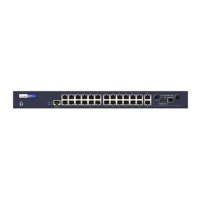




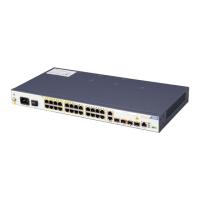

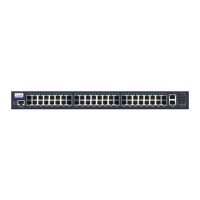
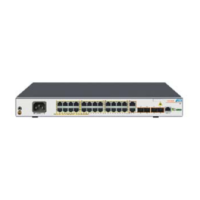
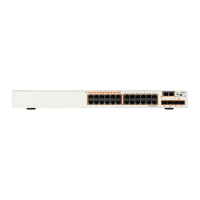

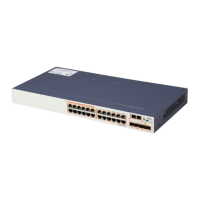
